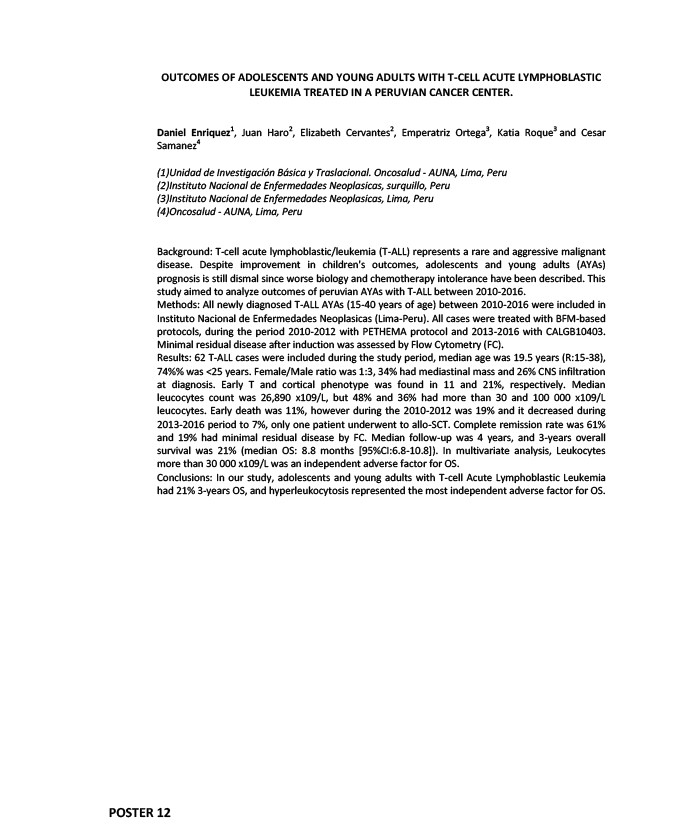
OUTCOMES OF ADOLESCENTS AND YOUNG ADULTS WITH T-CELL ACUTE LYMPHOBLASTIC
POSTER 12
LEUKEMIA TREATED IN A PERUVIAN CANCER CENTER.
Daniel Enriquez1, Juan Haro2, Elizabeth Cervantes2, Emperatriz Ortega3, Katia Roque3 and Cesar
Samanez4
(1)Unidad de Investigación Básica y Traslacional. Oncosalud - AUNA, Lima, Peru
(2)Instituto Nacional de Enfermedades Neoplasicas, surquillo, Peru
(3)Instituto Nacional de Enfermedades Neoplasicas, Lima, Peru
(4)Oncosalud - AUNA, Lima, Peru
Background: T-cell acute lymphoblastic/leukemia (T-ALL) represents a rare and aggressive malignant
disease. Despite improvement in children's outcomes, adolescents and young adults (AYAs)
prognosis is still dismal since worse biology and chemotherapy intolerance have been described. This
study aimed to analyze outcomes of peruvian AYAs with T-ALL between 2010-2016.
Methods: All newly diagnosed T-ALL AYAs (15-40 years of age) between 2010-2016 were included in
Instituto Nacional de Enfermedades Neoplasicas (Lima-Peru). All cases were treated with BFM-based
protocols, during the period 2010-2012 with PETHEMA protocol and 2013-2016 with CALGB10403.
Minimal residual disease after induction was assessed by Flow Cytometry (FC).
Results: 62 T-ALL cases were included during the study period, median age was 19.5 years (R:15-38),
74%% was <25 years. Female/Male ratio was 1:3, 34% had mediastinal mass and 26% CNS infiltration
at diagnosis. Early T and cortical phenotype was found in 11 and 21%, respectively. Median
leucocytes count was 26,890 x109/L, but 48% and 36% had more than 30 and 100 000 x109/L
leucocytes. Early death was 11%, however during the 2010-2012 was 19% and it decreased during
2013-2016 period to 7%, only one patient underwent to allo-SCT. Complete remission rate was 61%
and 19% had minimal residual disease by FC. Median follow-up was 4 years, and 3-years overall
survival was 21% (median OS: 8.8 months 95%CI:6.8-10.8). In multivariate analysis, Leukocytes
more than 30 000 x109/L was an independent adverse factor for OS.
Conclusions: In our study, adolescents and young adults with T-cell Acute Lymphoblastic Leukemia
had 21% 3-years OS, and hyperleukocytosis represented the most independent adverse factor for OS.